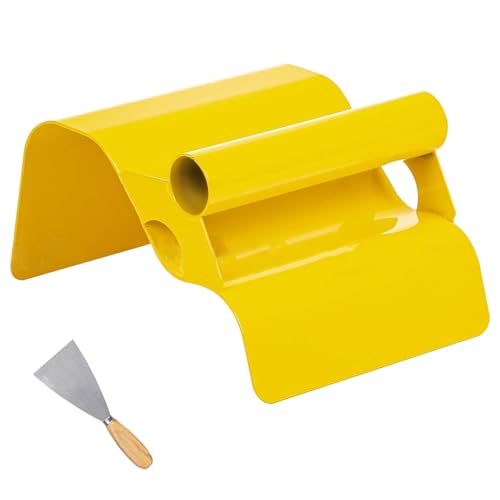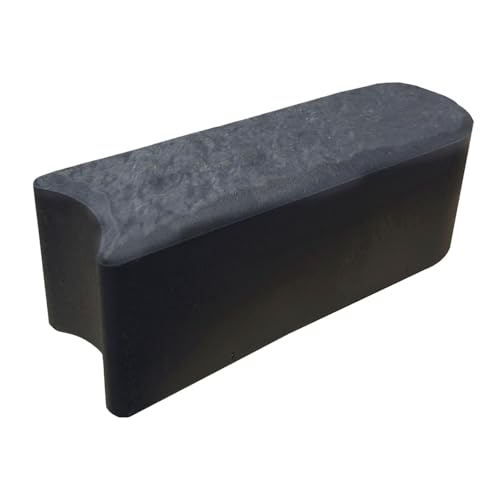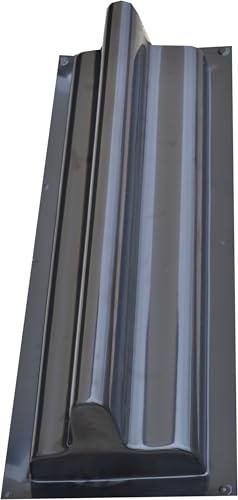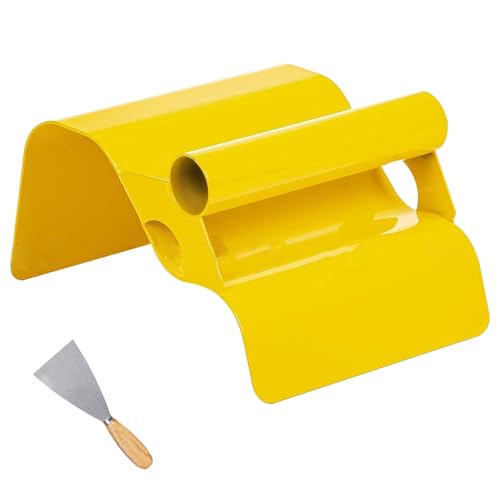Best Concrete Path Edging
—
A well-defined path can significantly enhance the aesthetic appeal and functionality of any outdoor space. Achieving that perfect look often hinges on selecting the best concrete path edging.
More than just a decorative element, effective edging prevents erosion, contains landscaping materials, and creates a crisp, clean border. However, navigating the myriad of options available can be overwhelming.
Settling for subpar products can lead to costly replacements and a less-than-desirable outcome. Investing in quality and value from the outset is crucial.
This review article explores the importance of choosing the best concrete path edging for your needs, helping you make an informed decision that balances durability, aesthetics, and long-term performance. We aim to guide you towards achieving a professional and lasting finish for your garden paths and walkways.
—
IN THIS ARTICLE
Top 10 Best Concrete Path Edging Compared

🏆 BEST OVERALL Pcmursal Concrete Curb Trowel
- Durable stainless steel construction.
- Ergonomic handle design for comfortable use.
- Includes a putty knife for added versatility.
- Suitable for both DIY and professional use.
4.5/5
Check Price on Amazon

🥈 2ND RUNNER UP Oversized 2Pack Walk Maker Reusable Concrete Path
- Easy to use, no special skills required.
- Reusable, made of durable polypropylene.
- Relatively large size reduces working time.
- Simple to clean before concrete sets.
4.8/5
Check Price on Amazon

� BEST VALUE Xanadued Concrete Curb Trowel Edger
- Durable stainless steel construction.
- Ergonomic handle design for comfortable grip.
- Compact size for easy handling.
- Includes a putty knife for added utility.
4.6/5
Check Price on Amazon

TBVECHI Garden Fence Concrete Mold
- Enables creation of custom concrete pathways and fencing.
- Lightweight and manageable plastic construction.
- Relatively easy to use, suitable for DIY projects.
- Reusable for creating multiple bricks or blocks.
4.6/5
Check Price on Amazon

Generic 12 inch, 10 Pack
- Durable concrete construction.
- Easy installation.
- Flexible design allows for straight lines or curves.
- Suitable for lawn edging and tree rings.
4.4/5
Check Price on Amazon

Garden Central 12-Pack 12”x4” Stomp Rubber Edge Stone
- Environmentally friendly due to recycled materials.
- Durable and weather-resistant for year-round use.
- Easy and tool-free installation.
- Versatile for various outdoor applications.
4.5/5
Check Price on Amazon

Avalution Plus Size 20″x20″x1.8″ Walk Maker Reusab
- Large size increases efficiency.
- Reusable and made from durable polypropylene.
- Easy to use, requiring no special tools or expertise.
- Allows for customization of path design and appearance.
4.5/5
Check Price on Amazon

Plastic Mold for Concrete Curb DIY – Durable Reusa
- Set of two molds provides efficiency.
- Reusable ABS plastic construction for multiple uses.
- Suitable dimensions for standard garden and path edging.
- Designed to create clean and uniform concrete curbs.
4.8/5
Check Price on Amazon

Anothera 17.5″x15.5″x1.5″ Walk Path Maker Reused C
- Relatively easy to use, even for beginners.
- Reusable and made of durable polypropylene.
- Creates a unique, irregular brick pattern.
- Allows for customization of pathways and borders.
4.4/5
Check Price on Amazon

3PACK, 12FT Total Length Wood Garden Edging Border
- Made from natural wood material.
- Easy to install.
- Flexible design allows for various shapes.
- Durable construction with metal wire connectors.
4.6/5
Check Price on Amazon
Detailed Reviews of the Best Concrete Path Edging
Pcmursal Concrete Curb Trowel – Durable stainless steel construction.

This concrete curb trowel edger is constructed from stainless steel, which promises durability and resistance to rust. The compact size (5.9″ x 4.3″ x 7.2″) and ergonomic handle are designed for comfortable use during extended periods of concrete work. The trowel is intended for smoothing and defining concrete curbs for various applications like garden paths and landscape borders.
A putty knife is included, which adds to the tool’s versatility for smoothing, patching, and removing excess cement. It appears suitable for both DIY enthusiasts and professional users involved in landscaping and construction projects, particularly those working with concrete curb maker machines. The trowel seems relatively straightforward to use, involving filling, tamping, and finishing with the tool to create well-defined curbs.
Pros
- Durable stainless steel construction.
- Ergonomic handle design for comfortable use.
- Includes a putty knife for added versatility.
- Suitable for both DIY and professional use.
- Compact size for easy maneuverability.
Cons
- The small size might not be ideal for very large projects.
- Effectiveness relies on proper concrete mixing and tamping techniques.
Oversized 2Pack Walk Maker Reusable Concrete Path – Easy to use, no special skills required.

This paving mold is designed for creating custom pathways and borders in your yard. It boasts ease of use, requiring no special skills or tools, making it accessible to beginners. Made from heavy-duty polypropylene, the mold is reusable, allowing you to create a continuous path.
Its size, 23.6″x19.7″x1.8″, is intended to reduce working time by covering a larger area per pour. Cleaning is straightforward – simply rinse with water before the concrete hardens. The manufacturer emphasizes customer satisfaction and offers after-sales support if you encounter any issues.
Overall, this product appears to be a practical solution for DIY landscaping projects.
Pros
- Easy to use, no special skills required.
- Reusable, made of durable polypropylene.
- Relatively large size reduces working time.
- Simple to clean before concrete sets.
Cons
- Requires concrete and tools not included (mixing tools, trowel).
- Results heavily dependent on the user’s concrete mixing and application technique.
Xanadued Concrete Curb Trowel Edger – Durable stainless steel construction.

This landscape curb trowel is constructed from stainless steel, promising durability and resistance to rust. Its lawnmower shape, coupled with an ergonomic handle, aims to provide a comfortable grip and ease of use. The trowel’s compact size (approximately 6 x 7.3 x 3.7 inches) makes it manageable for various edging tasks.
The inclusion of a 3-inch putty knife adds value, allowing for minor repairs and cleanup of excess cement. It’s designed for landscaping applications such as creating concrete borders in gardens, sidewalks, and patios. While it seems primarily intended for smaller DIY projects, its robustness should lend itself to repeated use.
Pros
- Durable stainless steel construction.
- Ergonomic handle design for comfortable grip.
- Compact size for easy handling.
- Includes a putty knife for added utility.
Cons
- May be too small for large-scale projects.
- Limited to edging and small repair tasks.
TBVECHI Garden Fence Concrete Mold – Enables creation of custom concrete pathways and fencing.

This brick cement mold allows users to create custom concrete pathways and fencing. The mold is made of plastic and is relatively lightweight, making it manageable to work with. The dimensions suggest it produces a reasonably sized brick or block.
The description highlights its suitability for DIY garden projects, offering a way to personalize outdoor spaces. The process involves mixing cement, filling the mold, smoothing the surface, and demolding, which seems straightforward. The product is intended for creating sidewalks, paths, and other outdoor features, with an emphasis on reusability.
While plastic construction may limit longevity compared to metal alternatives, it offers an accessible and affordable option for smaller-scale garden projects.
Pros
- Enables creation of custom concrete pathways and fencing.
- Lightweight and manageable plastic construction.
- Relatively easy to use, suitable for DIY projects.
- Reusable for creating multiple bricks or blocks.
- Suitable for sidewalks, paths, patios, and other outdoor features.
Cons
- Plastic construction may not be as durable as metal alternatives.
- Relatively small size may require more repetitions for larger projects.
Generic 12 inch, 10 Pack – Durable concrete construction.

This concrete lawn edging offers a durable and relatively straightforward solution for defining garden beds or creating tree rings. The concrete construction suggests long-lasting performance, although the aesthetic may not suit all tastes. Installation is described as easy, and the flexible design allows for both straight and curved layouts.
It’s important to note that while each piece is 12 inches long, the effective length after overlapping for connection is 11 inches. This 1-inch overlap needs to be factored in when calculating the total number of pieces required for a project. Overall, this product appears to be a functional and reasonably priced option for basic landscaping needs.
Pros
- Durable concrete construction.
- Easy installation.
- Flexible design allows for straight lines or curves.
- Suitable for lawn edging and tree rings.
- Relatively inexpensive landscaping solution.
Cons
- The connected length is 11 inches, not the advertised 12 inches (due to overlap).
- Concrete look might not fit all aesthetic preferences.
Garden Central 12-Pack 12”x4” Stomp Rubber Edge Stone – Environmentally friendly due to recycled materials.

This product boasts a sustainable design, utilizing recycled materials which is a definite plus for environmentally conscious consumers. Its all-weather durability suggests a long lifespan and reliable performance in various climates. The promise of effortless, tool-free installation is appealing, especially for those who aren’t particularly handy.
Its versatility lends itself to numerous outdoor applications, from patios to garden borders. Finally, the easy maintenance aspect – simply rinsing with a hose – further reduces the overall effort required to keep it looking good. While the product sounds promising, it is important to see how the lightweight material will withstand long-term wear and tear and extreme conditions.
Pros
- Environmentally friendly due to recycled materials.
- Durable and weather-resistant for year-round use.
- Easy and tool-free installation.
- Versatile for various outdoor applications.
- Low maintenance – easy to clean with a hose.
Cons
- Long-term durability of lightweight recycled materials is uncertain.
- Performance in extreme weather conditions may vary.
Avalution Plus Size 20″x20″x1.8″ Walk Maker Reusab – Large size increases efficiency.

This 20″x20″x1.8″ concrete mold offers a large surface area, which can be a real time-saver for creating paths and walkways. Made from heavy-duty polypropylene, it appears durable and capable of repeated use. The mold is straightforward to use; simply place it, fill it with concrete, and remove it once set.
The product description emphasizes the freedom to customize your path’s design, including color and direction, making it suitable for various outdoor spaces like gardens and courtyards. While the large size is beneficial, consider storage space when not in use. Overall, it seems like a practical tool for DIY enthusiasts looking to create customized outdoor pathways.
Pros
- Large size increases efficiency.
- Reusable and made from durable polypropylene.
- Easy to use, requiring no special tools or expertise.
- Allows for customization of path design and appearance.
- Versatile for use in various outdoor settings.
Cons
- The large size might be difficult to store.
- Finished look will depend on user’s concrete mixing and finishing skills.
Plastic Mold for Concrete Curb DIY – Durable Reusa – Set of two molds provides efficiency.

This product offers a set of two ABS plastic molds designed for creating concrete curbs. The stated dimensions of 505x140x100 mm appear suitable for standard garden and path edging. The molds are constructed from ABS plastic with a thickness ranging from 1.9-2 mm, although the description notes potential variations in wall thickness depending on the mold’s geometry.
The key benefit is the mold’s reusability, enabling users to produce multiple concrete curbs for various landscaping applications. The product aims to provide a consistent and clean finish for DIY concrete curb projects. Consider the potential for slight variations in wall thickness when planning your project.
Pros
- Set of two molds provides efficiency.
- Reusable ABS plastic construction for multiple uses.
- Suitable dimensions for standard garden and path edging.
- Designed to create clean and uniform concrete curbs.
Cons
- Potential for variations in wall thickness depending on mold geometry.
- ABS plastic, while reusable, may not be as durable as other materials for long-term intensive use.
Anothera 17.5″x15.5″x1.5″ Walk Path Maker Reused C – Relatively easy to use, even for beginners.

This paving mold offers a relatively straightforward way to create custom pathways, patios, or borders in your yard. Made from polypropylene, the mold appears durable and is designed for repeated use. The irregular brick shape provides a somewhat natural, DIY aesthetic.
The mold’s dimensions (17.5″x15.5″x1.5″) are manageable for most users. The product aims to be user-friendly, even for those without prior experience in paving. Cleaning with water before the concrete sets is essential for reuse.
It seems suitable for small to medium-sized projects and can be a fun DIY activity.
Pros
- Relatively easy to use, even for beginners.
- Reusable and made of durable polypropylene.
- Creates a unique, irregular brick pattern.
- Allows for customization of pathways and borders.
- Suitable size for manageable DIY projects.
Cons
- Requires careful cleaning before concrete sets to ensure reusability.
- The irregular shape may not appeal to everyone; style preference is subjective.
3PACK, 12FT Total Length Wood Garden Edging Border – Made from natural wood material.

This wooden garden fence offers a simple and straightforward way to define garden beds and borders. Constructed from wood, it appears relatively durable and weather-resistant, though long-term performance remains to be seen. The connecting metal wires seem to provide good structural integrity.
Installation is touted as being easy, requiring minimal tools. The fence’s flexibility allows for various shapes and designs, accommodating different garden layouts. The carbonized wood finish provides a somewhat rustic aesthetic.
Overall, it’s a functional and potentially attractive option for basic garden edging needs.
Pros
- Made from natural wood material.
- Easy to install.
- Flexible design allows for various shapes.
- Durable construction with metal wire connectors.
- Suitable for defining and separating garden areas.
Cons
- Long-term weather resistance is unknown.
- Potential for wood to fade or require maintenance over time.
Buying Guide: What to Look For in a Best Concrete Path Edging
Types of Concrete Path Edging
Choosing the best concrete path edging involves understanding the different types available. These include pre-cast concrete edging, poured concrete curbs, concrete molds for DIY paths, and even tools for creating custom edges. Pre-cast options offer convenience and uniformity, while poured concrete allows for greater customization. Concrete molds provide a cost-effective way to create unique pathway designs, and specialized tools like curb trowels help achieve professional-looking finishes on concrete path edging. Each type has its own advantages in terms of cost, installation ease, and aesthetic appeal.
Factors to Consider
When selecting concrete path edging, several factors should influence your decision. Consider the overall design of your garden or landscape; the edging should complement the existing style. Durability is crucial, especially in harsh climates. Think about the ease of installation – are you comfortable with DIY, or will you need professional help? Budget is also a key consideration, as prices can vary significantly depending on the type of edging and installation method. Remember to account for the long-term maintenance needs of the chosen concrete path edging.
Materials and Durability
The material used in concrete path edging plays a significant role in its longevity. Pre-cast concrete is generally very durable and weather-resistant. Concrete molds are often made from polypropylene or ABS plastic, which offer good reusability. Some edging options incorporate recycled materials, offering an eco-friendly choice. When choosing concrete path edging, ensure the material is suitable for your local climate, withstanding freeze-thaw cycles, heavy rain, and intense sunlight. Proper installation is also crucial for maximizing the lifespan of your concrete edging.
Installation Methods
The installation method varies depending on the type of concrete path edging you choose. Pre-cast edging typically involves digging a trench and setting the pieces in place, possibly with a concrete base for added stability. Poured concrete requires formwork and careful mixing of concrete. Concrete molds are relatively simple to use, involving filling the mold with concrete and allowing it to set. Always follow the manufacturer’s instructions for the best results. Consider your DIY skills and the complexity of the installation when selecting the right concrete path edging.
Aesthetics and Design
The appearance of your concrete path edging can significantly impact the overall look of your outdoor space. Pre-cast edging comes in various styles, from simple straight lines to more decorative designs. Concrete molds allow for creative patterns and shapes, enabling you to customize your path. Consider the color and texture of the concrete to ensure it complements your existing landscaping. Think about how the edging will integrate with your plants, lawn, and other garden features. The best concrete path edging enhances the beauty and functionality of your outdoor areas.
Frequently Asked Questions about Best Concrete Path Edging
What are the benefits of using concrete path edging compared to other materials?
Concrete path edging offers exceptional durability and longevity compared to wood or plastic alternatives. It withstands harsh weather conditions, resists rot and insect damage, and provides a clean, defined border for your pathways. Concrete’s versatility allows for various design options, from simple straight lines to intricate curves and patterns. While initial costs might be higher, the long-term value and low maintenance requirements make concrete a cost-effective and aesthetically pleasing choice for enhancing your landscape and defining the best concrete path edging.
How do I choose the right size and style of concrete path edging for my garden?
Consider the scale of your garden and the style of your home when selecting the size and style of concrete path edging. For smaller gardens, narrower edging may be more appropriate to avoid overwhelming the space. Taller edging can provide a more dramatic effect in larger gardens. Choose a style that complements your existing landscaping – simple, straight lines for a modern look, or more ornate designs for a traditional feel. Think about the color and texture of the concrete to ensure it blends seamlessly with your garden’s overall aesthetic.
Can I install concrete path edging myself, or do I need to hire a professional?
The installation difficulty depends on the type of concrete path edging you choose. Pre-cast edging is relatively easy to install yourself, requiring basic digging and leveling skills. Poured concrete and custom curb creation require more expertise and specialized tools, so professional installation is recommended. Concrete molds offer a DIY-friendly option for creating unique pathways, but proper preparation and technique are still important. Assess your skills and the complexity of the project before deciding whether to DIY or hire a professional for your concrete path edging project.
How do I prepare the ground before installing concrete path edging?
Proper ground preparation is crucial for a successful concrete path edging installation. Start by marking the desired path and removing any grass, weeds, or debris. Dig a trench along the marked line, ensuring it’s deep enough to accommodate the edging and a base layer of gravel or sand. Compact the soil in the trench to create a stable foundation. Level the base layer of gravel or sand to ensure the edging sits evenly. This thorough preparation will prevent settling and ensure your concrete path edging lasts for years.
What tools and materials do I need to install concrete path edging?
The tools and materials required depend on the type of concrete path edging you’re installing. For pre-cast edging, you’ll need a shovel, level, rubber mallet, and possibly a concrete base mix. For poured concrete, you’ll need formwork, concrete mix, a mixing container, and finishing tools like a trowel. Concrete molds require concrete mix, a shovel, and a trowel. Always wear appropriate safety gear, including gloves and eye protection. Following proper safety steps will ensure a successful and safe installation of the best concrete path edging.
How do I maintain concrete path edging to keep it looking its best?
Maintaining concrete path edging is relatively simple. Regularly sweep or hose down the edging to remove dirt and debris. Use a mild detergent and scrub brush to clean any stains or algae growth. For stubborn stains, consider using a concrete cleaner specifically designed for outdoor use. Seal the concrete every few years to protect it from the elements and prevent cracking. With minimal effort, you can keep your concrete path edging looking beautiful for years to come.
What are some design ideas for using concrete path edging in my landscape?
Concrete path edging can be used in various creative ways to enhance your landscape. Use it to define garden beds, create winding pathways, or edge patios and walkways. Incorporate curves and angles for a more organic look. Combine concrete edging with other materials like gravel, mulch, or stones for added texture and visual interest. Consider adding lighting along the edging to create a warm and inviting ambiance at night. The possibilities are endless when it comes to designing with concrete path edging.
Can I paint or stain concrete path edging to match my home or garden?
Yes, you can definitely paint or stain concrete path edging to customize its appearance. Choose a paint or stain specifically designed for concrete and follow the manufacturer’s instructions carefully. Clean the concrete thoroughly before applying the paint or stain. Consider using a sealer after painting or staining to protect the color and prevent fading. Experiment with different colors and techniques to create a unique and personalized look that complements your home and garden.
How do I repair cracked or damaged concrete path edging?
Small cracks in concrete path edging can often be repaired with a concrete patching compound. Clean the cracked area thoroughly and apply the patching compound according to the manufacturer’s instructions. For larger cracks or significant damage, you may need to remove and replace the affected section of edging. Ensure the new concrete matches the existing color and texture as closely as possible. Proper repair will restore the structural integrity and aesthetic appeal of your concrete path edging.
What are the environmental considerations when choosing concrete path edging?
Consider the environmental impact of your concrete path edging choice. Look for options that incorporate recycled materials, such as recycled aggregate or fly ash. Choose a local supplier to reduce transportation emissions. Opt for permeable concrete edging to allow rainwater to drain back into the ground, reducing runoff. Properly dispose of any waste materials from the installation process. By making environmentally conscious choices, you can minimize the impact of your concrete path edging on the planet.
Conclusion: The Final Verdict
The Pcmursal Concrete Curb Trowel overall, this concrete curb trowel edger seems to be a well-designed and versatile tool for creating smooth and defined concrete curbs. the stainless steel build and ergonomic handle are positive features, making it a worthwhile investment for both diyers and professionals. recommended for smaller to medium-sized landscaping projects.



